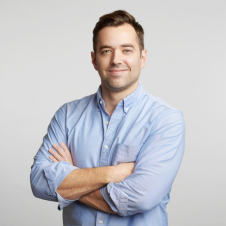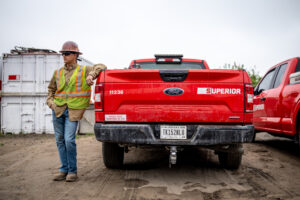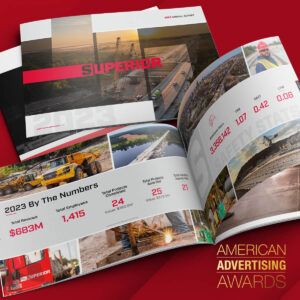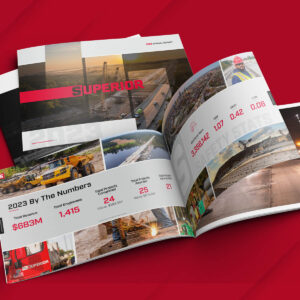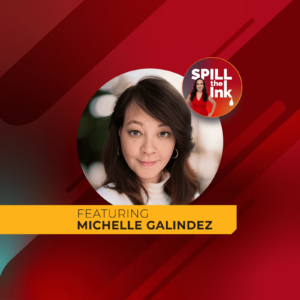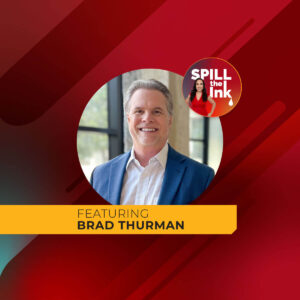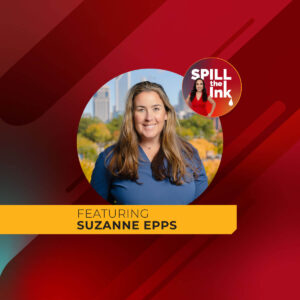
Spill the Ink: The Reputation Ink Podcast
Architecture marketer spotlight: Marketing analytics, photography and a people-centric strategy
Michael Mantese brought a fresh perspective to Eskew Dumez Ripple, a nationally recognized architecture firm, when he joined in 2017. Coming from a New York City digital marketing and advertising agency, he brought a data-driven, people-centric approach to the firm’s marketing and content creation strategies. As marketing director, he leads the firm with the same values and elevates its brand storytelling through his photographer’s eye.
In this episode, Michelle chats with Michael about tools and strategies for cutting-edge architecture marketing, content ideation and amplification, and how marketing departments can leverage analytics and technology. Michael also shares how his photography background influences his marketing work, including ways marketers can collaborate with photographers to tell better project stories.
Here’s a glimpse of what you’ll learn
- Who is Michael Mantese is
- About Eskew Dumez Ripple
- The growing importance of data analytics in effective marketing
- Insights into Eskew Dumez Ripple’s research-based content ideation approach
- How to repurpose project case studies and proposals into omnichannel content
- Ways thought leadership can support proposal writing (and vice-versa)
- How Eskew Dumez Ripple leverages technology as a competitive advantage
- New ideas for leveraging photography to tell better project stories
About our featured guest
Michael Mantese brings a storyteller’s craft to communicating Eskew Dumez Ripple’s brand identity and mission. A writer at heart, he expands this skillset with a background in user experience design — letting market insights, data and analytics drive his decision-making, rather than assuming he knows what every audience is thinking. He augments this storytelling with a keen visual eye and maintains a particular fondness for photography and typography.
Before joining Eskew Dumez Ripple, Michael worked in the tech industry, designing digital experiences for some of the world’s biggest brands, including Marriott, Amex and City University of New York (CUNY).
Resources mentioned in this episode
- Check out Eskew Dumez Ripple
- Follow Eskew Dumez Ripple on X, Facebook, LinkedIn and Instagram
- Connect with Michael Mantese on LinkedIn
- Say hello to Michelle Calcote King on X and LinkedIn
- Read the latest on EDR+
Sponsor for this episode
This episode is brought to you by Reputation Ink.
Founded by Michelle Calcote King, Reputation Ink is a public relations and content marketing agency that serves professional services firms of all shapes and sizes across the United States, including corporate law firms and architecture, engineering and construction (AEC) firms.
Reputation Ink understands how sophisticated corporate buyers find and select professional services firms. For more than a decade, they have helped firms grow through thought leadership-fueled strategies, including public relations, content marketing, video marketing, social media, podcasting, marketing strategy services and more.
To learn more, visit www.rep-ink.com or email them at [email protected] today.
Transcript
[00:00:00] Michael Mantese: I don’t think we’ve ever subscribed to the notion of, you know, architects as the old guy working in a cave, like with a cape on and then coming out and delivering a finished product. We always see like our best work as coming out of collaboration.
[00:00:13] Announcer: Welcome to “Spill the Ink,” a podcast by Reputation Ink, where we feature experts in growth and brand visibility for law firms and architecture, engineering and construction firms. Now, let’s get started with the show.
[00:00:33] Michelle Calcote King: Hi, everyone! I’m Michelle Calcote King. I’m your host, and I’m also the principal and president of Reputation Ink. We’re a public relations and content marketing agency for architecture, engineering and construction and other professional services firms. To learn more, go to www.rep-ink.com.
Eskew Dumez Ripple is a national architecture firm that specializes in design, interiors and urban planning across an array of markets. The New Orleans-based firm was founded in 1989 and has since evolved into a nationally-recognized firm with projects spanning states like Georgia, Florida, and Tennessee.
And today we’re talking to Michael Mantese, Eskew’s marketing director. We’re excited to pick his brain and learn more about running a marketing department as successful as Eskew’s. So welcome to the show.
[00:01:20] Michael Mantese: Thanks so much for having me. Excited to be here.
[00:01:22] Michelle Calcote King: Yeah, excited to chat with you. So, tell us a little bit about how you got into architecture marketing.
[00:01:28] Michael Mantese: It is a long story that I’ll try to keep as brief as possible. So, I started my career in the tech industry after graduating from the University of New Orleans.
I moved to New York for a few years, and there the advertising and marketing ecosystem is just, you know, exploding. And I had kind of, like, a number of firms to pick from that I wanted to work at. And I ended up working at a relatively small boutique, kind of, digital marketing and advertising agency for about two years while I was there.
The cold eventually got too much for me in New York and I decided to make my run home back to New Orleans. And when I came back here that kind of world that I was super familiar with there in the, you know, advertising and marketing just wasn’t as big here. There aren’t as many firms. There’s kind of like two big ad agencies and I looked into those and then just by kind of, like, happenstance saw a listing for what at the time was called a content manager.
And I had a good friend of mine that was working at Eskew Dumez Ripple at the time. And I reached out to him and asked kind of, like, what the role entailed. And he told me, you know, it’s primarily, like, writing for proposals and things like that. And since I’ve started — it’s been five years now — the role has kind of just, like, evolved into this whole new world that is kind of, like, all things marketing and BD now, which I’m super excited to take on.
[00:02:44] Michelle Calcote King: Awesome. Well, that actually leads perfectly into my next question, which was to talk about how marketing has evolved over your years.
And I know in AEC firms, often marketing can be just pure proposal. So tell me how that changed over the years.
[00:03:00] Michael Mantese: So I’ll tell you kind of my pitch when I started at Eskew Dumez Ripple. It was primarily one that encouraged leadership and everyone in the firm to kind of take a role in marketing and simultaneously leverage all the data we had internally to, you know, make insights into improving or doing things differently.
I think for so long in the industry and for architects, especially, it’s kind of done by gut, you know, you know? We have a good feeling about this. Maybe we should do this. Oh, we see this peer firm doing that.
And my perspective was really, you know, even though we’re a services firm and we don’t offer a product that you can, like, track sales of really closely to see like whether your marketing is performing. My point was really that, you know, you can harness other data and other insights to really drive how you’re doing your marketing. So I think that’s kind of, like, the big way the whole industry has changed. It’s gone from just being kind of like a person-to-person handshake business to one that’s really, like, national in scope.
We consider ourselves a national firm. We opened a second studio in Washington, D. C., three years ago. And lately it’s been about how do we expand our digital footprint and reach those new prospective clients to really, like, change the world and elevate our design nationally.
[00:04:16] Michelle Calcote King: Oh, I love that. Give me an example of what kind of data you’re utilizing.
[00:04:20] Michael Mantese: So for everything we do in social media — I’ll just give you kind of a peek behind the curtain there — we use a tool called Sprout Social, which I think many of your listeners are probably familiar with. And so, you know, for everything we post, we have, like, categories or buckets of things and posts typically, like, live in one of those. And we try to track how different posts are performing in terms of those typologies.
We do similar things for our blog and our website. Our website is integrated, basically, in the back-end into Google Analytics. So, like, our CMS itself has, like, Google Analytics side-by-side. You can look at pieces of content and then simultaneously see how they’re performing. So that’s kind of the short answer.
[00:05:01] Michelle Calcote King: Yeah, yeah, absolutely. And you’re right. For, especially professional services firms that used to be so bound by geography, the internet has opened that up and made it to where it, you know, it’s no longer a geography-bound, handshake-driven business. It can be very much so a national– It changed marketing. It kind of flipped it on its head.
[00:05:21] Michael Mantese: Right.
[00:05:22] Michelle Calcote King: One of the things that I saw on your site that I really wanted to dig into is the EDR+. Can you tell me about that?
[00:05:28] Michael Mantese: That has an interesting backstory at the firm. I’ll reveal kind of, like, the nitty gritty of everything it entailed.
We’ve always had a research fellow in-house and what that person is is someone we hire on an annual basis — and sometimes it’s two people, one on kind of, like, a three-month duration and the other that is on a year-long duration. And they’re hired to basically, like, explore cutting-edge topics and architecture outside of, like, traditional practice, but embedded in an architectural firm. So it’s really interesting. Like, past fellows have explored things as varied as like, our first one was around sustainability when sustainability was just becoming like a very big topic ten years ago.
Since then they’ve explored topics like social justice in the built environment; carbon, trying to make various building and case studies we have internally go completely carbon neutral and doing kind of, like, explorations on what that would entail. So many different topics.
So the EDR+ started when the first fellow started and it was a way for them to kind of, like, showcase the things that they were exploring through their fellowship. And I think by way of that, we discovered we really enjoyed kind of the content we were putting out through that and we decided to take it basically firmwide. So since then, it has harnessed the voices of everyone in the studio to just talk about or explore topics that they’re interested in outside of projects and marketing tries to support them wherever possible to elevate those voices internally and explore some really interesting topics kind of across the industry.
[00:06:58] Michelle Calcote King: Thought leadership, but it didn’t start as marketing thought leadership. It started as– Interesting. Do you put an analytical data eye on that as well?
[00:07:10] Michael Mantese: We do. We look at kind of numbers under the hood all the time. But at the same time, I think it’s about kind of just elevating the individual voices in the firm. And so we focus less on whether something’s going to perform really well and more on if we think something’s interesting, we think someone might find things interesting. And sometimes it’s the most interesting posts that kind of, like, blow up.
We did one, I want to say four or five years ago on, like, a Revit plugin that we thought was pretty dry and we’ve discovered since that it’s one of our most referenced EDR+ posts, and people continue to reference it basically to this day. The numbers just keep going up, which is funny.
[00:07:48] Michelle Calcote King: Interesting.
Tell me what channels do you, you know, put the most resources and time in? Is it social? Is it video? Is it email? Is it all of the above? And what is taking most of your focus nowadays?
[00:08:03] Michael Mantese: Yeah. We’ve got, I think, an interesting outlook on this, in that the thing that kind of comes first are what we call, like, case studies, and those just occur internally, like, when a project is finished, mostly talking about projects right now and not people. And the case studies kind of become the foundation of awards. And then we pull them apart, basically, to create all these other things. So we use them in social media posts, we basically rework them to live on the website. Sometimes we’ll take them and expand on a certain piece to do a white paper or something like that.
So it feels like from those case studies we then are able to focus on a lot of different things.
[00:08:40] Michelle Calcote King: Got it. So you start with the project itself, and then you go channel. So you break it up–
[00:08:45] Michael Mantese: Right.
[00:08:45] Michelle Calcote King: –and populate it and use it as much as you can. Yeah, that’s smart.
[00:08:49] Michael Mantese: And sometimes that project feature turns into, like, a people feature.
In the case of one of our recent projects, The Bruce Museum in Greenwich. That is an amazing project and really transformed the museum for our client but it’s also a story about our design director, Steve Dumez and, basically, his long history in civic and cultural projects and also in the civic and cultural world, just supporting clients behind the scenes on boards and things like that.
So it was kind of an interesting story about how he’s just been able to serve the arts over the years, both through architecture and then through like, you know, civic activism. So that’s become a really interesting story, too.
[00:09:27] Michelle Calcote King: Yeah.
Tell me about your team. How big is it and what are the roles?
[00:09:33] Michael Mantese: We are three currently. And it’s sort of, like, ebbed and flowed over the years. I think we’ve had as many as four, sometimes two. So I’m the marketing director and I’d say like, if I am largely strategy and writing and things at this point, I have two people.
One, a graphic designer, and she comes from the nature conservancy. And so sort of like an ancillary world to architecture, and just brought all these amazing skills in terms of like how we visually display our work.
And then we also have a marketing coordinator who is basically three months in at this point, but just finished her master’s degree at UGA and comes with, like, all this amazing talent as it relates to, like, PR and social media and things like that.
[00:10:19] Michelle Calcote King: Oh, that’s great. I was going to ask you about PR. How much do you put into PR?
[00:10:23] Michael Mantese: We do a lot of work to support a consultant that we have. And basically that is, again, supplying them with all the assets they need to go out into the world and pitch our stories. So it’s a lot of, like, content creation for them and then they’re doing kind of the pitching for us.
[00:10:39] Michelle Calcote King: Yeah, they’re doing the legwork and, and getting you guys out there.
[00:10:42] Michael Mantese: Because it’s hard, I think. You can have one person solely focused on PR these days and there’s so many avenues and it can take a lot of a person’s time.
[00:10:50] Michelle Calcote King: Yeah. Well, it’s interesting you haven’t mentioned proposals. How is that structured within your team?
[00:10:55] Michael Mantese: I’m always not hesitant, but curious what people want to talk about because I think marketing and BD are kind of like intertwined in architecture, but, proposals are very much in marketing’s world, even though they’re a business development focus.
[00:11:09] Michelle Calcote King: I always wonder ’cause some marketers it’s like their entire world and others are like, “If I have to focus on that, I’m never going to get any of this done.” So, you know, they silo it off, which I understand. So I’m just interested to see how you approach that.
[00:11:24] Michael Mantese: So we have a marketing content calendar that we try to adhere to as much as possible. And even in the face of proposal deadlines, we try to have stuff ready and be very proactive about that content. And so when proposals come up or, you know, five interviews drop in our laps, we still have time to do that other content creation.
But I mean, proposals frequently come first or, you know, that’s how we win work still, unfortunately. I mean, as a really design-first practice, that’s how we compete for a lot of our work. I think maybe for other firms, it’s a little different but we are very still proposal heavy.
And we see all of the other stuff in marketing, like content creation, supporting that. When we do proposals, we’re trying to simultaneously create content alongside the proposal that can support it. So if a client, you know, is reading that RFQ or RFP response, comes to our website, they see something that kind of reflects what we were showing in that proposal.
[00:12:20] Michelle Calcote King: Yeah, and it helps that if you’re involved in the other content, you know that you have the content to support the proposal and it integrates well.
[00:12:28] Michael Mantese: Right.
[00:12:28] Michelle Calcote King: That makes sense to me, too.
So I noticed your website had a dedicated page to technology and innovation. Can you tell me about, one, why you kind of decided to kind of give it that focus? And tell me why you’re kind of messaging around that and and how you’re doing that.
[00:12:44] Michael Mantese: So we started as a firm in New Orleans, which I think historically has the unfortunate misconception that we are slow adopters of technology. I think it’s always been the opposite in our firm. We’re early adopters, especially with things like the research fellow. New technology is kind of getting integrated on a monthly, if not weekly basis in addition to kind of a BIM manager, which I think is, I guess the word would be, like, uncommon at a firm of our size.
You know, usually you think of a BIM manager in the context of the really, really big firms of the world. At a size of 60, of 70, we’ve always had a BIM manager. And then also we have a digital technology manager who is focused on all things that integrate with BIM and Revit360 and all that, but is also all of the other things we’re doing in the office. And I think with everything related to the pandemic, it accelerated a lot of that stuff, but we’ve always been really early adopters of, like, new programs, new technologies to support the things we’re designing.
[00:13:44] Michelle Calcote King: Yeah. That’s interesting that, yeah, if you have a perception challenge existing to kind of really confront that, you know, headfirst and to make that a priority.
This thing I wanted to ask about was your background in photography. Does that come into play at all in your work?
[00:13:59] Michael Mantese: It definitely does in a lot of different ways. I’ll talk about just, like, two that I think a lot of firms could be leveraging photography differently and a way that I’ve seen is, you know, so much of our projects in New Orleans are about transforming existing buildings and adaptive reuse, and I think that’s a really big conversation nationwide now. And I found where some architects struggle to showcase those stories is when they have amazing finished photography and nothing of how the space was or how it came before. So I’m a really early advocate of getting into the project before we’ve, you know, designed or demoed everything to show how it existed prior to our interventions and then also capturing it afterwards.
And so, you know, I’ve done photography forever. It is, I think, an amazing tool for architects generally. We’ve also, I think, recently been big advocates too, of not just architectural photography as it, you know, traditionally has lived with, like, the building from the outside, but those like small moments that users really interact with. And I think maybe that was something I brought in when I started. Just having photographed, like, everything under the sun and being interested in lots of different aspects of photography.
[00:15:13] Michelle Calcote King: I can imagine it’s hard to be the photographer that you’re hiring, too.
[00:15:17] Michael Mantese: Yeah. We hire externally for some projects and we work with a lot of really amazing names.
Tim Hursley, photographer from Arkansas, who has just an absolutely astounding portfolio and it’s always really interesting for us to collaborate because he sees things in such a unique way and you’re hiring a person like him for his eye. But at the same time, it’s like trying to collaborate and like show them the stories that we really love in the project. So that kind of, like, give and take is really interesting when we go to photograph work.
[00:15:50] Michelle Calcote King: Yeah. That’s what you want. You want someone to bring something to the table that you wouldn’t bring.
So tell me what’s next. What are your priorities for this year?
[00:15:58] Michael Mantese: Priorities for this year?
We did a website redesign in 2019, which I think in website terms is getting not long in the tooth, but is due maybe for a refresh. So we’re looking at our marketing budget right now in February and trying to figure out what role website redesign will have in that, and I think it’s going to be a sizable one this year.
In general, I think the website does a great job of showcasing projects and sort of, like, the granularity of the work. What we want to see it do better, I think, is showcase the people more and kind of, like, the thought process behind projects. It’s constantly in, like, a state of becoming. We’ve made like small improvements over the years and I think this year it’s going to be a bigger one. So I guess that’s the big thing that’s next.
[00:16:41] Michelle Calcote King: Yeah. Websites are just big, big projects. Yeah. So my website is 2014, so talk about an old website. I’m feeling the pain and I’ m redesigning ours this year.
[00:16:51] Michael Mantese: Yeah. Well, I was going to say too, if it’s working for you, then it’s working for you, you know?
[00:16:55] Michelle Calcote King: Yes. But you just, yeah, after a while it feels old and you can only patch it up for so long. You know, websites are living, breathing things and you do have to constantly update them, but yeah, you know, the technology… You know, you can only go so long so they really do get to a point.
So tell me about the showcasing people. And you’ve said that your strategy has been to really focus on the projects. When you move toward that focus on the people, do you have an idea of how you’re going to approach that? Any sort of idea around that strategy?
[00:17:24] Michael Mantese: For the website, nothing specific yet, but I feel like across the board for marketing, the strategy has been about sharing the things that people internally are excited about and shining a light on kind of just like the work individuals are doing.
I don’t think we’ve ever subscribed to the notion of, you know, architects as the old guy working in a cave, like with a cape on and then coming out and delivering a finished product.
We always see, like, our best work is coming out of collaboration. And I think, especially today with a firm of 60 and people from, like, all kinds of really interesting backgrounds across the US and internationally, we’re bringing such, like, unique insights to all of our work. So showcasing that confluence of ideas and insights from a lot of different people, I think is really important to us right now.
So we’re doing that through a number of ways. It’s, you know, it’s kind of like process stories. It’s things totally unrelated to architecture that, you know, our architects, our designers are exploring outside the office. It’s really just kind of showcasing, I guess, the way individuals in the firm think and how that contributes to the larger ethos and our larger mission.
[00:18:35] Michelle Calcote King: Right.
Well I like to end interviews with asking you sort of, you know, if you could leave our listeners with one final thought around marketing an architecture firms. So one lesson that you’ve learned over the years, what would that be?
[00:18:48] Michael Mantese: You know, it’s fresh in mind cause I basically just said it, but I think it’s about elevating your people and your projects simultaneously.
The projects only happen because of the people and for everyone online in the marketing world, I think the people are the most interesting thing. You know, other architects are very interested in the architecture. I think our clients are interested in the people and the process, because those are the things they’re going to interact with before they get a finished project.
[00:19:13] Michelle Calcote King: Absolutely. Absolutely. That’s who’s going to impact it.
Well, we’ve been talking to Michael Mantese of Eskew Dumez Ripple. So if people want to get in touch with you, what’s the best way for them to do that?
[00:19:24] Michael Mantese: They can, you know, find me on our website. We have our emails all attached to that. Or, you know, we have our Instagram, EskewDumezRipple. Any of those avenues would be great.
[00:19:33] Michelle Calcote King: Well thank you for joining me.
[00:19:34] Michael Mantese: Thank you. This was great. I had a great time.
[00:19:38] Announcer: Thanks for listening to “Spill the Ink,” a podcast by Reputation Ink. We’ll see you again next time and be sure to click “Subscribe” to get future episodes.
Related AEC and Architecture.
Maximizing Employee Engagement Through a Compelling Employee Newsletter
Reputation Ink | Jun. 24, 2025
Rebuilding a Construction Company’s Brand with Impactful Visuals
Reputation Ink | Jun. 24, 2025
How AEC Firms Can Communicate Urgently Yet Empathetically in the Wake of a Natural Disaster
Reputation Ink | Jun. 24, 2025
Join the INKsights Email List
Get Exclusive Updates on Awards, Lists, Rankings, Editorial Opps and More.
Subscribe to our newsletter, INKsights, to receive insights (pun intended) on thought leadership, public relations, and marketing for B2B professional services firms sent straight to your inbox.
Available only to our email subscribers:
Once a month, you’ll receive the latest awards, rankings, lists and editorial opportunities in the legal or AEC industry (you choose which you’d like to receive).
In the off weeks, we send you our latest thinking on the marketing and PR issues facing those industries. You can opt out anytime (although we’ll bet our favorite coffee mug you’ll never want to leave).
